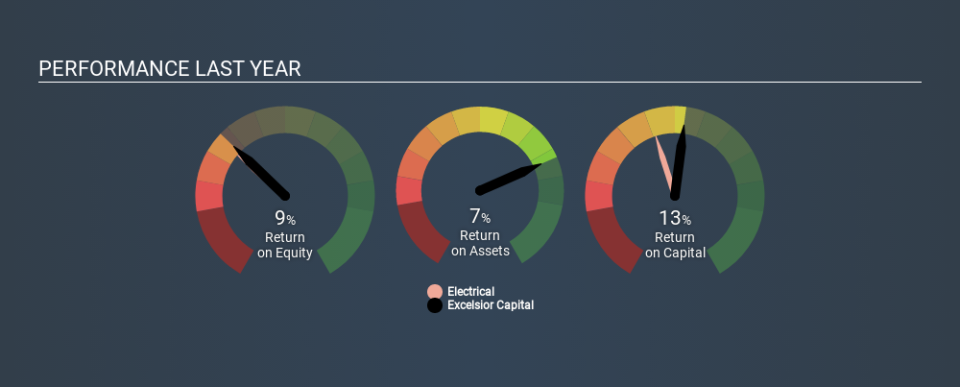Are Excelsior Capital Limited’s (ASX:ECL) Returns Worth Your While?

Today we'll look at Excelsior Capital Limited (ASX:ECL) and reflect on its potential as an investment. To be precise, we'll consider its Return On Capital Employed (ROCE), as that will inform our view of the quality of the business.
First of all, we'll work out how to calculate ROCE. Then we'll compare its ROCE to similar companies. Last but not least, we'll look at what impact its current liabilities have on its ROCE.
Return On Capital Employed (ROCE): What is it?
ROCE measures the 'return' (pre-tax profit) a company generates from capital employed in its business. Generally speaking a higher ROCE is better. Overall, it is a valuable metric that has its flaws. Renowned investment researcher Michael Mauboussin has suggested that a high ROCE can indicate that 'one dollar invested in the company generates value of more than one dollar'.
So, How Do We Calculate ROCE?
The formula for calculating the return on capital employed is:
Return on Capital Employed = Earnings Before Interest and Tax (EBIT) ÷ (Total Assets - Current Liabilities)
Or for Excelsior Capital:
0.13 = AU$6.2m ÷ (AU$56m - AU$8.3m) (Based on the trailing twelve months to June 2019.)
Therefore, Excelsior Capital has an ROCE of 13%.
Check out our latest analysis for Excelsior Capital
Is Excelsior Capital's ROCE Good?
ROCE can be useful when making comparisons, such as between similar companies. We can see Excelsior Capital's ROCE is around the 15% average reported by the Electrical industry. Independently of how Excelsior Capital compares to its industry, its ROCE in absolute terms appears decent, and the company may be worthy of closer investigation.
In our analysis, Excelsior Capital's ROCE appears to be 13%, compared to 3 years ago, when its ROCE was 9.9%. This makes us think about whether the company has been reinvesting shrewdly. The image below shows how Excelsior Capital's ROCE compares to its industry, and you can click it to see more detail on its past growth.
Remember that this metric is backwards looking - it shows what has happened in the past, and does not accurately predict the future. ROCE can be misleading for companies in cyclical industries, with returns looking impressive during the boom times, but very weak during the busts. ROCE is, after all, simply a snap shot of a single year. How cyclical is Excelsior Capital? You can see for yourself by looking at this free graph of past earnings, revenue and cash flow.
What Are Current Liabilities, And How Do They Affect Excelsior Capital's ROCE?
Current liabilities include invoices, such as supplier payments, short-term debt, or a tax bill, that need to be paid within 12 months. The ROCE equation subtracts current liabilities from capital employed, so a company with a lot of current liabilities appears to have less capital employed, and a higher ROCE than otherwise. To check the impact of this, we calculate if a company has high current liabilities relative to its total assets.
Excelsior Capital has total assets of AU$56m and current liabilities of AU$8.3m. As a result, its current liabilities are equal to approximately 15% of its total assets. Current liabilities are minimal, limiting the impact on ROCE.
Our Take On Excelsior Capital's ROCE
Overall, Excelsior Capital has a decent ROCE and could be worthy of further research. There might be better investments than Excelsior Capital out there, but you will have to work hard to find them . These promising businesses with rapidly growing earnings might be right up your alley.
If you are like me, then you will not want to miss this free list of growing companies that insiders are buying.
If you spot an error that warrants correction, please contact the editor at editorial-team@simplywallst.com. This article by Simply Wall St is general in nature. It does not constitute a recommendation to buy or sell any stock, and does not take account of your objectives, or your financial situation. Simply Wall St has no position in the stocks mentioned.
We aim to bring you long-term focused research analysis driven by fundamental data. Note that our analysis may not factor in the latest price-sensitive company announcements or qualitative material. Thank you for reading.

 Yahoo Finance
Yahoo Finance 
